Derek Arden Part One Reading Body Language
[THIS IS A TRANSCRIPT OF THE INTERVIEW – JILL ENGLISH]
Derek – Hello everybody welcome and this is Derek Arden. I’m delighted you’ve joined me for this session on reading body language.
I found body language a really, really, really important skill as I learned my trade as a professional negotiator, and it was when I was working in the financial services industry, I did some small talks, as one does to get a feel for it, to build up my own negotiating system, from reading every book I could get my hands on, every tape every CD programme, that I could get my hands on.
And I found an interesting fact as I talked to people, I found that most people weren’t aware that it was crucial to watch the body language of somebody when you asked them a question, you asked them a difficult question. “So how much did you pay?”, or “What have you been offered from another client?” or some difficult question like that that we all should ask us as negotiators. And people that I was with weren’t noticing people going back, people folding their arms, people rubbing their noses, etc.
So I got really interested in body language at that stage, and I was with a client, and it was a £25 million loan, and we weren’t convinced that the client could repay in six months time, which is what he was telling us that he could do. And I said to him, “Are you sure you can repay in six months time?” And he went back, and he rubbed his nose. At that point, and I thought, “Wow, there’s really something in this body language! Now what am I going to do, because he doesn’t believe he can repay, I’ve picked up the signal he doesn’t believe he can repay, and I’ve got to put this up to the credit committee, etc?”
Anyway, that’s a story for another day, but that’s how I really got into reading body language.
Now my plan today is to share some slides with you, some pictures slide that I use on my masterclasses and on my talks, and when I’m talking on body language, and we’re gonna put them up now and go for it.
Body Language Structure

Right, so this is the structure of the session tonight: key principles, first impressions observation skills, your space or mine, the silent signals, gestures, eyes, smile, deception rapport, culture, fun, and summary – they’re the points I wrote in this body language book that I wrote a number of years ago. And I’m going to see how much of that we can get through in the next 17 minutes.
Key Principles

So, body language key principles: number one, make sure your awareness and your radar are on, to be watching the body language.
People lie; it’s five times more difficult to lie with body language than it is with the words.
Then I’m going to talk about the psychology of how the brain works, why we don’t pick the body language up when we’re stressed, when we’re under pressure when we’re tired, and also managing our own body in that.
And then, at the next session, we’re talking about gestures, eyes, posture, space and feet.
The impact of communication

So, the impact of communication came from the original study, which was done by Albert Mehrabian in California in 1972. Basically, this study showed that 55% of the impact of communication came from the body language, 38% on the way it was said, and just 7% from the words. Now this study has been disproved by all sorts of further studies, by more MRI scanning etc. Except, the body language is so important that whether it’s 55, whether it’s 40, whether the words are 20, it doesn’t really matter; it just shows the impact of persuasion skills will be so powerful, from body language and of course all politicians know that and if they didn’t know that, they would never get elected because of newspapers, or press, YouTube would pick up any incongruent body language at that point.
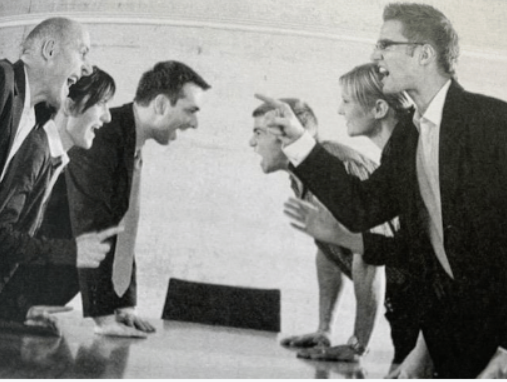
That’s a picture from my first book that I put in about body language and what do we notice from that? We notice that they’re sitting on opposite sides of the table, no they’re not, they’re standing, they’re pointing their fingers – be careful when you’re persuading someone, don’t start pointing your finger, that’s seen as a gun, as a weapon, etc. And also, clearly, it’s a bit of a fun picture, but they’re not doing very well.
Left Brain – Right Brain

Now I did some research into the left and right brain when 1980s and 1990s, and the left side of the brain works logic, reading, writing, maths, and analysing, and the right side of the brain is visual information, body language, intuition, emotions, colours and seeing the big picture. Ladies and gentlemen, the more tired we get, the more the left brain kicks in, and we stop noticing things, and therefore we need to notice, that’s why it’s really important to take someone with you to a negotiation, or to a business meeting, we want to see where the other side’s coming from. We want someone watching the body language, and you want, if you’re concentrating on the left-brain things, that you won’t be watching the body language or seeing the big picture.
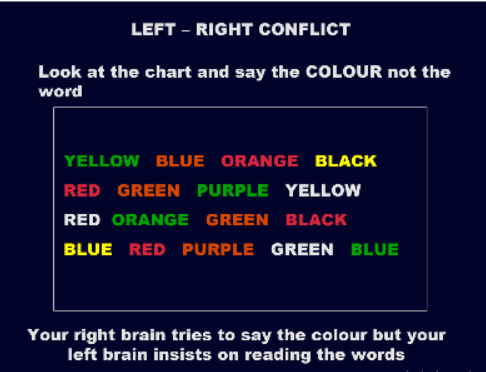
You may have seen this before. It’s called a Stroop test the Stroop test says, look at the chart and say the colour, not the word. And as you can see that’s pretty difficult isn’t it. Not to say yellow, rather than green and what actually happens is your right brain tries to say that colour. But your left brain insists on reading words. That’s why we need to take a time out. That’s why we need to de-emotionalize a situation where we’re getting wound up ourselves. That’s why we need a break. That’s why you should never agree to something, when you’re emotional, you should stop, take a breather.
Observation Test

Now I’d like to ask you what relationship is the man on the phone with the three people, he’s talking to. One’s his wife, one’s the office, and one, I’m sad to say is his lover, which is which?
Group – Office on the left,
Derek – [Left to right, office, then wife, then] lover. Everybody got that? It’s very – not everyone gets that, it’s very interesting, when we’re saying something to someone and we’re not comfortable, and we want to hide it, funnily enough, even though no one else can hear us, our body language moves in to a posture, where we can tell what the people are thinking about. And this is really helpful for us as body language readers, as leaders, as managers, as negotiators, because we want to know what the person’s thinking, because we’re going to get much better results if we know what they’re thinking.

What do you think my, my pal Justin Urquart-Stewart (oh, by the way, he’s coming on the show on the fifth of October, I’ve just agreed to get him back on), what do you think he’s thinking? Is he happy? No way. Is he bored? Is he about to fall asleep? Any of those ladies and gentlemen, I just want to say to you, if you look bored in a meeting, and then you’re going to try and persuade the rest of the meeting to do what you want, they will have picked up your boredom. And therefore, you won’t get what you want. You will not get your way, and the degree of boredom, they say, is the degree of the head on the hand.
Unfamiliar

So, moving on, one of the things I get people to do on my seminars, I want you to do it – how many people have got a watch on? If you’ve got a watch on, I want you to take it off, please, and put it on the other wrist. This is not negotiable, you’ve got to do it, put it on the other wrist.
How does that feel? It feels really odd, doesn’t it, it feels really odd. Why do I get people to do that? Because it brings people back into the ‘now’, it takes them out of their unconscious mind, brings them back into ‘in the now’ and thinking, “Why, have I got my watch on the wrong wrist, it feels really odd?” When you go into a negotiation or business meeting, if you’re saying to yourself, “I want to watch the body language here. I want to watch how people are reacting, what they’re thinking,” then we have to do things differently. What I recommend to you is that you make a little note in your book, in your magic book, your nice book that you take into meetings, in very small, ‘Today we’re gonna watch the body language.
First Impressions
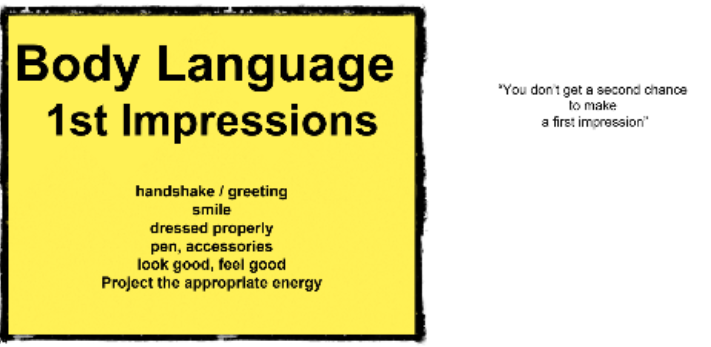
What You Wear
Okay, so the next step section. Section two, is about first impressions and I know I’ve talked about this before, but I’ll keep talking about it because people usually mess up the first impression. It’s really interesting on this call to Indianapolis last night. Tim had a jacket on, and I didn’t show up with a jacket. And I felt at a disadvantage. And I said, “Shall I go and get a jacket?” he said “No, that’s all right.” You can always dress down, but you can’t dress up, which is why I put a jacket on there so you don’t want to be at a disadvantage, all these small things make a massive difference.
Handshake & Greeting, Looking Good
Of course I put in handshake there, which we can’t do, but whether it’s an elbow nudge or a fist pump or whatever, it’s really important, that first impression, smiling, being dressed properly for the success you want, having a nice pen, not a chewed-up biro as some people have, good accessories. You look good. You feel good, and then you project the appropriate energy for the situation.

That’s Lauren. She’s well dressed, you’re negotiating with her. How are you getting on with the negotiations? Not very well. She’s got her eyes pouted, she’s got a pouted mouth, she’s got her arms folded.
Unfamiliar Again
I’d like you all to just sit back for a minute and fold your arms, please. Okay, this is not negotiable, you’ve got to do it, sit back, fold your arms. How many of you’ve got your left arm over your right arm? Fantastic. How many people have right arm over left?
Do you know what it means if you’ve got your left arm over your, your right arm? It means that you’re incredibly sexy. Lots of research has been done into this and I’m afraid it’s bad news for you if you’ve got your right arm over your left arm. It means that you’re incredibly good looking.
But why did I do that? That wasn’t the point, I want you to fold your arms the other way now please. How does that feel? It feels really strange, doesn’t it? It feels really strange, in fact some people can’t even do it, they go fluffing around like this. [gestures confusion crossing arms]. Why did I get you to do that again? Because if you’re going to be in a difficult situation, a difficult negotiation, you want to read the body language, you need to remind yourself to get outside your comfort zone and do things that you didn’t do, get out of that mindset of doing that.
Taking a Stance

So, there is Lauren again. What does that body language tell us, what does this body language tell us? Hands on hips, ready to go. That’s a great way of feeling confident, of being confident, of increasing the adrenalin in your system. And those of you that have watched the YouTube clip by Amy Cuddy
[ https://www.ted.com/talks/amy_cuddy_your_body_language_may_shape_who_you_are?language=en ]
will know that’s a great way of buzzing your self up before a meeting, hands-on hips, making your body bigger, just like a dog or a cat does when it’s under threat.
Reminding People What They Do
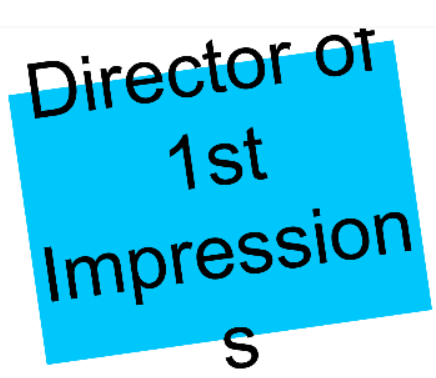
So, back to first impressions. I got some badges printed because I knew people were so bad, some of my clients, at the first impressions, I got some badges printed to give to them and it says director of first impressions. So rather than having it ‘receptionist’, or, you know, ‘whoever on the door’, make them the ‘director of first impressions’, it’s their job to make sure everything is fantastic, the answer phones are brilliant, the emails are superb, etc, etc, so you come across as a real professional. And take a look at what you do, your answer phone message how it comes across, et cetera.

But when I was in Dallas airport there was this virgin plane with the back of it from Richard Branson, ‘you never forget your first time’, and I love that, and you know with me being interested in psychology, I’ve always been interested why we remember our first kiss, we remember our first holiday, we remember our first date, remember our first girlfriend, boyfriend or whatever. And then when a piece of music plays that was number one in the charts, we also link back to them. And that’s an anchor in psychology.
Where Do You Sit?
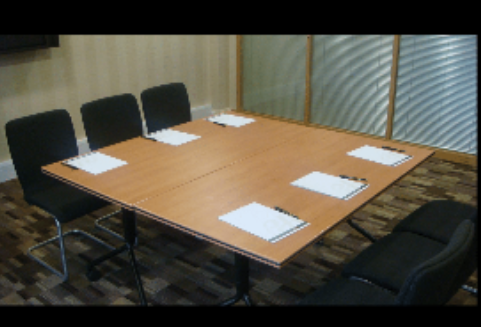
So where do you sit? Where do you sit and here we have the typical situation, anywhere around the world, 80% of the meeting rooms look like this, see people sitting across the table, too far apart to be at arm’s length, etc. rather than round the table in a nice, friendly, win win situation, because all these little things to manage the people, manage the body language in any situation, it’s vital to get a good result.
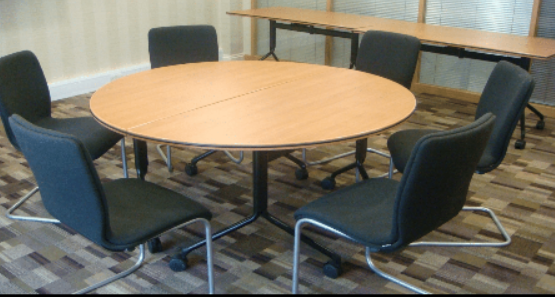
And if you don’t believe me, little things make a difference, try sleeping with a mosquito.
Open Face

And I was at the Royal Horticultural show at Hampton Court last year and this guy was trying to sell greenhouses, and I just could not believe that someone with glasses like that where you can’t see your eyes, was a professional salesman, paid a lot of money to be at for the RHS, and he had those stupid glasses on. So of course, you know what Derek did he has a sneaky look up, and he gets his camera out down here, and takes a picture of him, because when people are doing stupid, crazy things like that, it’s… and I know beards are very popular at the moment and lots of people have beards but if you’re in sales, and if you’re in influencing, you’re hiding your face subliminally, and if you hide your face from people subliminally, it may be more difficult to close the sale. I’ve had to stop saying that on seminars because, quite a lot of people who are – the men of course, I’m talking about have beards.
Observation Skills

Radar On
So now on to body language observation skills and I’m going to move through these quickly. Again, have your radar on, look, listen, sense, stay silent, is the body language congruent with what the people are saying. And is that contributing to seeing the whole picture when you start making decisions.
Look, Listen, Sense

I’ve shown you that before, I’ve shown that to a lot of people, I continue to show it to all sorts of people. That’s the old lady, is it the old lady, is it the young lady that you see there? 60% of people see the young lady, 40% of people see the old lady. Some people see both. It doesn’t matter. The point is, different people see different things, which is why in a difficult situation, you need to take somebody with you so you get two judgments of what’s in front of you.

But what about that statement ‘Finished files are the result of years of scientific research together with the combination of very hard work’?
Just take a couple of seconds out count the number of ‘F’s in that sentence and put it in the chatbox. Gabi Can you pick up the chatbox for me because I’m on full screen, I can’t see the chatbox. Okay. So ‘finished files are the result of years of scientific research, together with a combination of very hard work’, a statement by Bill Gates.
So, what’s coming in the chatbox Gabi? I’m sure some people have seen this before and they’re cheating but I think…
Gabi – A couple of sixes is a five.
Derek – Couple of sixes or five couple of threes.
Gabi – No threes
Derek – no threes – people have seen it before maybe. So ladies and gentlemen, I put this to you, I’ve shown this for a number of years it’s in my books. It’s in psychology A level textbooks. People tend not to see the f in ‘of’, you know of, because they see the of, but their right brain says it’s pronounced ‘ov’, and therefore, there are the six.

Gabi – you told them all to be very aware, you see so they’ve got their full radar on.
Derek – We’ve got the top people on this call, I send out 4000 newsletters yesterday, we got the top 16 people on there.

And, again, you’ve probably seen this before. Most people can never see the arrow in FedEx, because the awareness is not there, the radar is not there, and they don’t see the clear arrow, which is in the five words, and of course it faces forward on the right hand side of the van and it faces backwards on the left hand side.
So, raising your sensory awareness is crucial to your success.

Silence
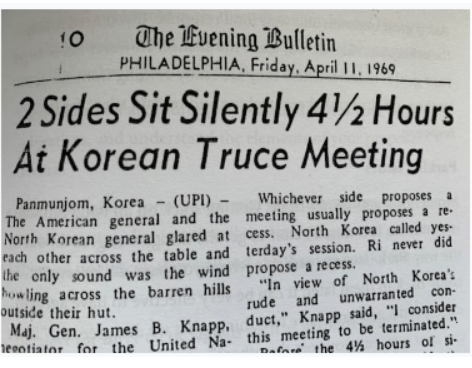
And somebody didn’t believe me last week when I said that two sides in the Korean peace talks sat and looked at each other for four and a half hours after they asked the question. “Now, what do you propose?” and they said, “Well what do you propose?” and then they sat there for four and a half hours. When we ask a good question, we’ve got to manage our body language and we’ve got to keep quiet. We’ve got to stay silent; we want to watch what’s going on.
Your Space Or Mine

Space is a very interesting issue with body language, as well, and ‘Space Invaders’, ‘my space are yours’ I like to talk about this. There are five distances. There’s the intimate zone. Five to 20 inches, where we’ll let people into our space, if it’s a close family member, and so forth. But most people will get very defensive, if you come, somebody else comes into their intimate zone. In fact, Gabi, I know you’ve walked people across the room at a party Avenue by just moving into their space, and they they’ve backed off. Quite an interesting thing to do when you’ve got your personal zone which is about 20 to 50 inches.
Gabi – You need to get this in metric as well.
Derek – It was in, metric I changed it to inches because I thought that – proud Americans, Brits and just Gregor, so sorry Gregor. And then we got the social zone, which is about four feet to 10 feet when you see people at networking events, remember that, and remember that arm’s length is generally in Western society the space for doing a deal, so that’s why you don’t want to sit across a desk more than arm’s length. Then we’ve got the public zone which is about 10 feet, and of course, I’ve just added, we then got the COVID zone which, I don’t think in this country anybody knows what it is really because I was in London on Tuesday and some people are walking around you as if you’ve got a plague and other people are bumping into you, so, I wasn’t really sure about that.
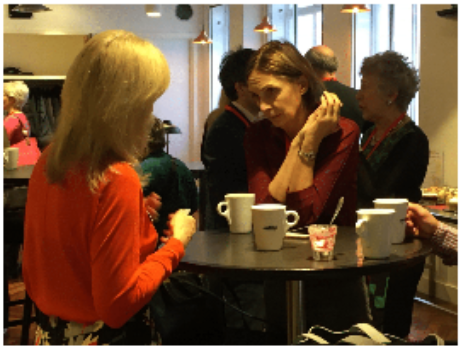
And you can see the two ladies in the picture I took of the two ladies. How far are they apart, do you think? Is the lady on the right invading the lady on the left’s space? I kind of thing she probably is.
But there’s a little fun thing you can do, or you can share with people – if you want to intimidate people. If the lady on the left moved her coffee cup into the lady on the right’s space, probably 90% of the time, the lady on the right, wouldn’t be able to take her eyes off of that cup, because her space has been invaded, and she’d want to move it, which is an amazing pattern interrupt, if you just want to throw people out. So, again, that’s something you can do,
Or if two people are out to dinner and one wanted to find out if the other one fancied the other one, move your wineglass into their space and see what happens – if it stays there, then you’re probably alright, and if it doesn’t stay there, they won’t be able to take their eyes off it and move it back.
Stand Up Meetings
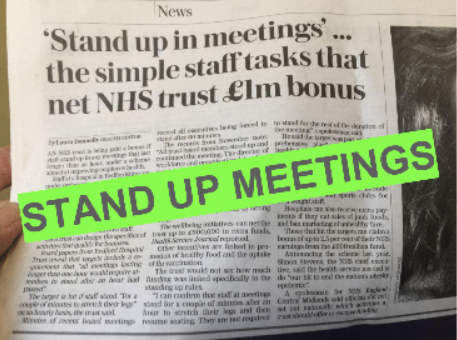
Okay, coming to the end but stand up meetings, I know we’ve got one or two friends from the National Health Service here, thanks for joining us.
I saw this in the Telegraph, I’m a great fan of stand-up meetings. The reason I’m a great fan is they don’t take very long, they’re much quicker, you feel more confident if you’re standing up, people don’t get too comfortable. You’ve got a bit more adrenaline flowing, the blood is flowing better to your head and it’s better for your back, and stand-up meetings don’t take very long at all.
I can’t believe someone got a million-dollar bonus for suggesting something that’s been in many, many personal development books over a number of years, but try it, people will think you’re a bit crazy but that doesn’t matter, we’re crazy because we’re listening to self-development tapes, books and YouTube videos.
Next Time…

So next time I do this, we can talk about the silent signals, we can talk about some gestures, we’ll talk about eye contact, smiling again because smiling takes 14 muscles, frowning takes 72, connecting, building rapport, some of the work from Bandler and Grinder on mirroring and matching, pacing and leading, cultural negotiations, which can be very interesting.
And Some Fun Things

I did go to a dinner, where the prime minister of the UK was, well she wasn’t the Prime Minister at the time, and it was in the House of Commons, and you’re not allowed to take photographs in the House of Commons, but you know me, I couldn’t resist it. I wanted a picture so I had my camera, very quietly on the table, hidden a bit so that’s why the water jugs are in the way. And I was clicking away, pretending I wasn’t doing anything. And she spotted me, and she gave me one of these most evil looks and I think she just looked away and I thought, oh my god I’ve been sussed and I’ll be thrown out in a minute.

So when she became prime minister I decided to send her a copy of my book, Win, Win, and my wife said, “You will never get a reply to that, sending the book, you’re just wasting your time,” and I got a charming reply back from her when I came back from holiday. And I didn’t show my wife and say, “Told *you so,” because that wouldn’t be a smart move.
So, ladies and gentlemen – Texas Tim, my coach and mentor from Texas says I have to be a bit more upfront with my marketing. If you’ve seen anything that you like today, please like it on social media or email me at Derek Arden or contact me to speak to any of your teams, but more importantly on this, watching it on YouTube, or the podcast take some an action because action is the key. I’m going to stop sharing now, ask Gabi what she may have seen in in the chat box and take a little glass of water because I’ve actually been talking for half an hour and I expected to talk for 20 minutes over to you, Gabi.
Questions and Comments
Table makes a difference?
Gabi – So, there was something around the social space and whether having a table makes a difference and yes, certainly a table does make a difference, having any kind of barrier makes a difference and it was mentioned that in dating, it’s a way of sussing out if you are in rapport if the other person is attracted to you by moving your cup along, or your wineglass or whatever it is, into their space, if they don’t do anything then that’s a good sign. If they then bring their cup into your space, then you know that you’re onto a winner, and that there is attraction there, so thank you for that Tony. There’s not been a great deal of chatter. There was something about the table, that was Rosie so thank you for that, that does make a difference.
I find is quite interesting for space because we’re all slightly different you know, the figures, although it’s an inches which means nothing to me, I have to say that the space … we’re all unique, and people that live in the country tend to have a much bigger personal space to those that are in London, you just need to go onto the tube in New York or London and everyone’s in your space. So actually doing the handshake, which you mentioned at the very, very beginning is very, very useful because generally people will give you an indication of, you know, ‘That’s my personal space, thanks’ and other people will bring you right in and shake your hand, really closely, which you might feel uncomfortable with, but it indicates to you what they feel comfortable with.
Request for a Zoom meeting with more on body language
Derek – that was great, that’s great. Bob Greenaway as asked if we could have a Zoom-style meeting and some body language with some backgrounds. Yes, we can, Bob, I’ve done one or two things on that and I sent you an article which has just been published in Industrial Intelligence.
Anyone who says to me you can’t watch the body language on Zoom is kidding themselves and being lazy, they probably don’t watch the body language in a meeting either. Of course you can, but you probably need someone with you to watch the body language, you probably need to take a timeout and, and then phone, and then come back on the meeting and you need to go outside the room because that was that case with Barclays in June where they hadn’t got Zoom switched off and the lawyers said, “She’s a bloody liar,” or something about this woman Amanda Staveley and they had to apologise to the judge the next day. So, but yeah, I’d be happy to do either a session with you, Bob, and some of your team or we’ll do a session on here, if the others would like that. There are some people that are experts on Zoom on here, like Duncan and Tony and Mark. And there’s other people that aren’t, so whatever you like and let me know, and I’d be delighted to do it either on a Thursday, or as a special session. Okay. Well no one’s on mute, are they, so you can ask ask me any questions you have.
Gender, culture and social space
Tim – Derek, I have a question with regard to social space. I don’t know if this is true in the UK, but when men speak with each other, they don’t speak face to face. When women speak with each other, they are very much face to face, but men try to go like this [angles his hands to 90 degrees of each other], because if we are face to face that’s known, at least in the states as ‘squaring off’ and squaring off is something prior to fisticuffs. Is it true in the, especially if you’re in personal space, which is in the US within arm’s length, if the other guy – and you don’t know him – is within arm’s length, facing you directly, almost every other man, unless he’s trying to make a point, would take a step back. It’ just not comfortable,
Derek – you’re spot on, Tim, I think it’s the same in the UK, I don’t know whether it’s the same in Eastern cultures, but I think in Western cultures it is, so it’s important to approach a woman, front on, and a guy from the side. Now sometimes I get that the wrong way around, I think I’ve got that the right way round, Gabi? but it’s absolutely right and that’s another reason not to sit across the table, one against another one because, again, it becomes hugely competitive.
Again, I’m told the research says that guys will start pumping up a bit of testosterone at that point, which is why if you’re around a table, and remember you’re setting this up, crucially important, you want to set the meetings up, Bob, you want to set the Zoom up because you can record it, you’ve got the controls if you set the Zoom meeting up and zoom works better than Microsoft Teams, because you can see everybody on the zoom call, you can’t see everybody on Microsoft Teams, I understand, so again.
Yes, yes. You’re absolutely right, there’s a lot of little nuances like this, but they don’t work across all cultures, which is why I wanted to do a separate session on cultures. The trick with cultures is to understand where you’re going, and I bet the culture is different in Dallas, than they are in San Francisco, where, where Tony is, again.
Reviewing the scores
So yes, next question. I’ll tell you what I’ll do in a minute, I’ll turn the turn the video off and stay on for questions as long as you like, I’d just like you to think of a number now between zero and 10, and put it in the chat box where you feel you are on reading body language, after this half an hour session, and what you’re going to do differently because of giving up your valuable time for something like this, therefore you should be implementing it and taking some action. Tim’s a 9.5, he’s gone down from a 10, I think.
Gabi – He was 9, he’s gone up, they’ve all gone up so it’s all good.
Derek – I’ve never met a modest Texan yet. They say in Texas, everything’s bigger in Texas, that includes egos so
Tim – we call it BS, yeah exactly, bigger. Yeah, well I’ll wait for the recording to go off.
Derek – I’m just gonna close it. Yeah. Thanks for joining us on YouTube, thank you for joining me on the negotiator’s podcast with 16 of my friends from all around the world that join me on a Monday, and a Thursday.
I do hope to hear from you actually at derekarden.co.uk, and make sure you up your sensory awareness and get that radar on so you get better results from picking up body language.
My name is Derek Arden, thanks for joining me.

